3: Cultivating A POV
You can't force a plant to grow. But you can create conditions that are conducive. Likewise with POV.
Developing Your Point Of View
Points of view emerge from a living relationship between you, your concern for your market, and your market itself. Can they instead be engineered? Manufactured?
Note
1: OK, fine, my experience is writing 3 terrible songs. Really terrible songs.
Not that I have any experience in songwriting [1], but I think it's a bit like songwriting. You can nurture points of view (and songs) into being. You can create the pre-conditions that make it more likely for a point of view to emerge. You can take a mess of opinions and sift through for good "POV material". You can polish a raw POV into something more impactful and effective.
But I do not think you can engineer or manufacture a POV from nothing. That begs the question: what is the something you must have to nurture a POV?
You have to care about your market's improvement. There is a much stronger causal relationship between genuine care for your market's wellbeing and impactful points of view than there is between expertise and POV, and between fame and POV.
In other words, a good POV is a second-order effect of caring about your market's wellbeing. As you've seen if you've read this far, there's quite a lot to say about POV itself, but there's nothing more to say about what births a good POV than this: you simply have to care enough to stick your neck out with a thoughtful perspective on what would make things better for those you seek to serve.
Maybe you have the requisite care for your market's improvement and wellbeing, but you don't think you have a great POV. You probably do have "POV raw material"; most people who have been around the block a time or two do. This chapter is about helping you surface that raw material. There are two groups of exercises here: one to help you filter the raw material that's currently floating close to the surface, and the other to help you surface new raw material that might be buried deeper in your thinking.
The POVSpace
When I run a workshop on point of view, I ask participants to locate themselves in a "POVSpace" that has 4 dimensions. Most participants tell me they enjoy and benefit from this exercise, but it can be challenging because it invites a sort of self-reflection that is new to many of us. As with everything else in this guide, I hope you don't get too in your head about this idea of POVSpace, rather I hope it helps you see behind the curtain of the points of view out there that you admire while making you more effective about refining your own POV.
For entrepreneurial experts in the licensed or unlicensed professional services space, there are 4 primary elements that make for a distinctive POV. We can think of each of these as an axis with two poles; we can describe your POV as a point — or more likely a range — along each axis. This is similar to personality characteristics. Nobody is 100% introverted or extroverted all the time, most of us are somewhere in between these two extremes, and most of us have some amount of range and fluidity in how we express introversion or extroversion.
Here are the 4 elements:
- What is your perspective? This will range between arguing from data, arguing from experience, or some combination of both.
- What kind of change are you arguing for? We can think of this as your change agenda. Do you seek radical transformation, progressive optimization, or something that lies in between these two extremes?
- With what argument style do you advocate for change? Do you encourage a rip-the-bandaid-off, disruptive approach to change, a gentle, evolutionary approach to change, or something in between? (A transformational agenda and an evolutionary change style are compatible.)
- From what status do you argue? Are you perceived as a pedigreed insider, an expert outsider, or something in between (or both, depending on which audience sub-segment you're interacting with)?
Yes, I know reality is complex and nuanced in ways this map can’t represent. And if you're an effective advisor, some aspects of your POV will be softened or accentuated based on the specifics of the context where you are trying to help a client apply your POV. And yet, there is value in forcing yourself to consider which of two binary poles your POV is closer to; the artificial simplicity can be clarifying and the sense of where your natural "center of gravity" lies can be empowering.
Map Yourself On The POVSpace Map
That's why I'd like you to take some time to think, reflect, and map your POV on this POVSpace Map. Here's how to do that.
The easiest way to explain this is to show you a completed POVSpace Map and explain how it was created. Here's how I'd map myself:
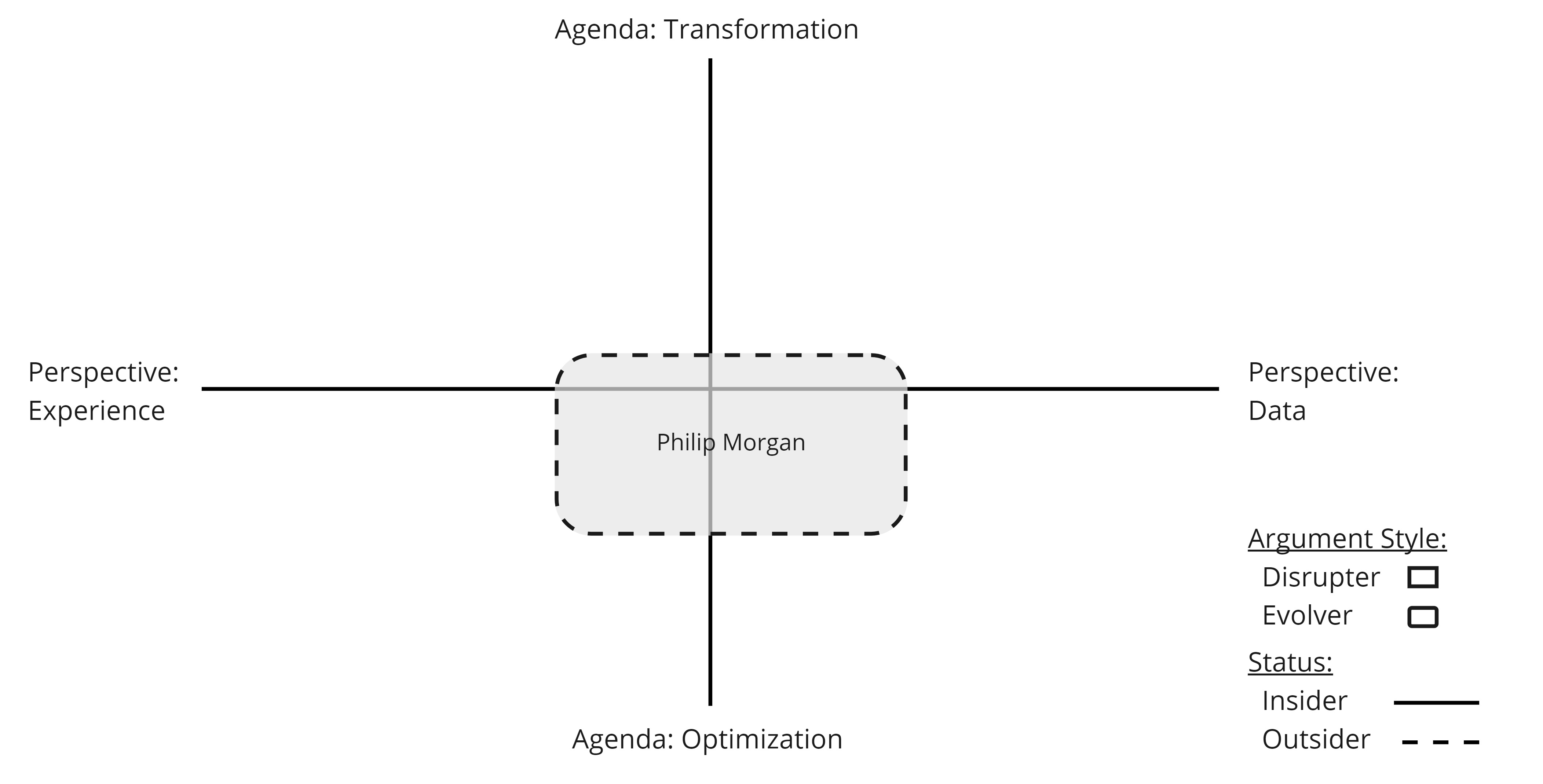
I see my POV as:
- Covering a range of agenda from mild transformation to moderate optimization. My work on lead generation skews towards optimization, while my work on positioning has a more transformational quality. I've represented this on the POVSpace map with a rectangle. You can see it covers the range from mild transformation to moderate optimization.
- My perspective is rooted in both experience and data. My argument for transformational change needs to have an inspirational feel to it, and it's easier to use experience to create that inspirational feel. But when I talk about lead generation, I have access to data that nobody else does, and that proprietary data becomes central to my argument there, causing me to use a more data-informed argument style. That's why the other 2 sides of the rectangle I've drawn on the POVSpace Map define a range from experience to data.
- Despite often arguing for transformational change, I do so with a gentle, evolutionary tone. I represent this on the map by using gently rounded corners for the rectangle I've drawn. If I wanted to represent a more sharp, disruptive change style, I'd use sharp corners on the rectangle.
- Finally, my status is mostly that of the expert outsider. I focus on custom software developers and digital agencies, yet I've never gotten paid for writing code. I do have a technical background and can talk like an insider in this world thanks to that background and actually caring about the world of software development, but I'd characterize my status as mostly expert outsider. If I could show this map to you in color, I would use one of two colors to represent status, but this booklet is printed in B&W, so I've used a dashed line to represent the expert outsider status, and I would have used a solid line to represent the pedigreed insider.
If at this point you understand how to use this map, you might go ahead and fill one out for yourself. I've printed a few of them on the following pages, and if you'd like a blank electronic one, grab this one: https://philipmorganconsulting.com/povspacemap
If you'd like to see a few more example maps, I've mapped out the POV of a few people's public work, some of which I hope you are familiar with. I'm doing my best to be accurate as I do so, but I hope it's clear these maps are built on my subjective impression of these people's work, not their own description of their own POV.
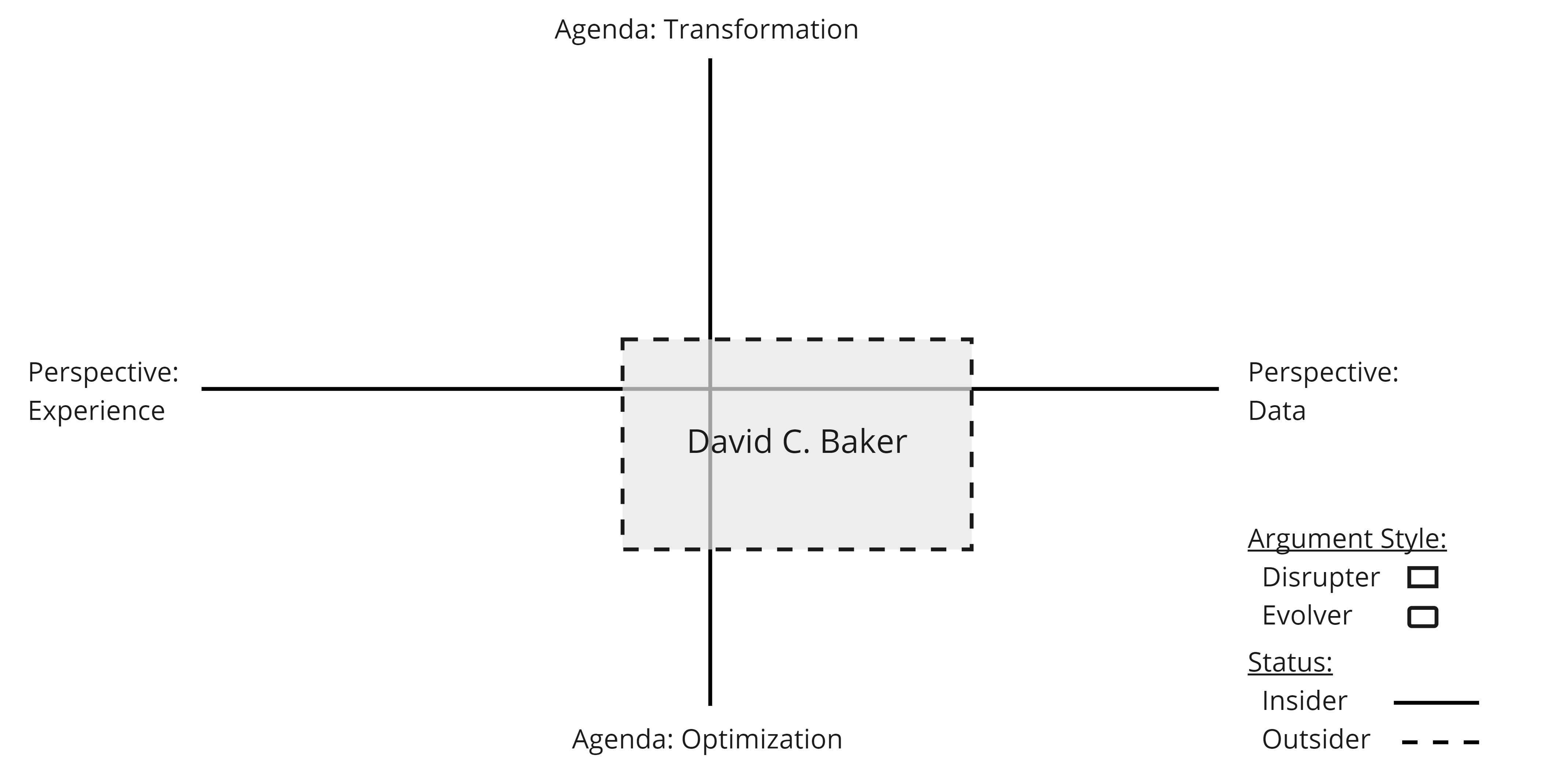
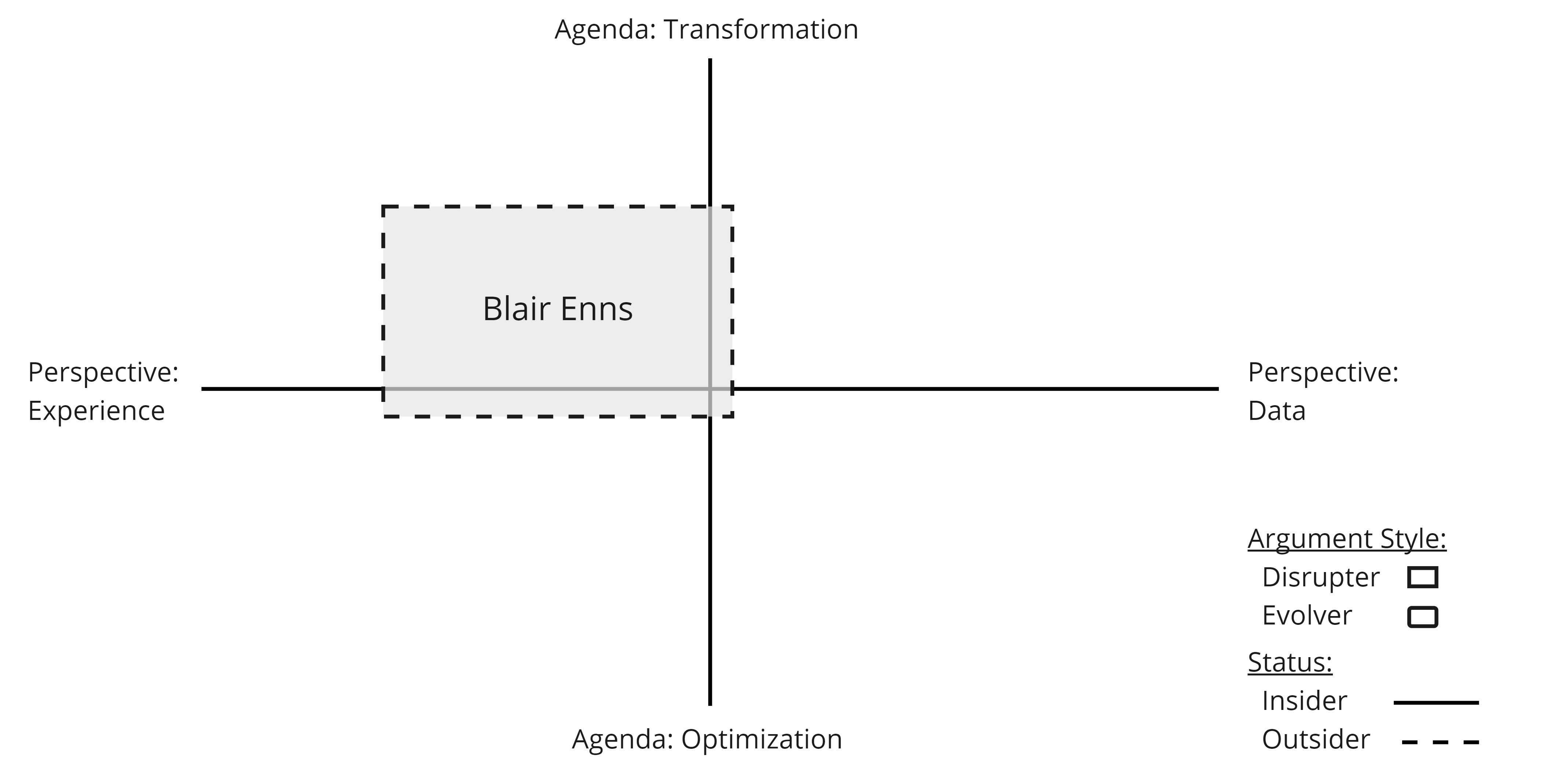
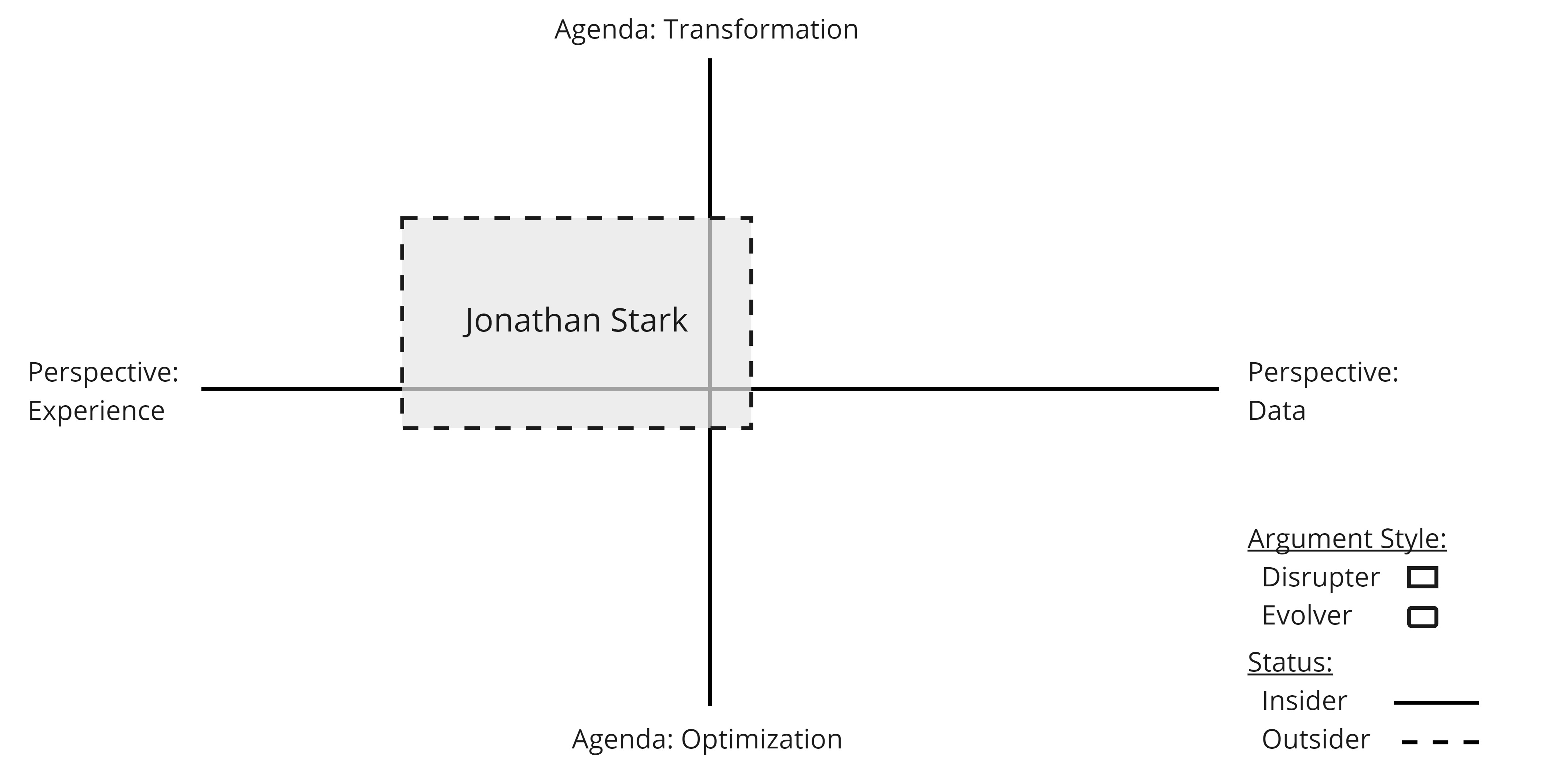
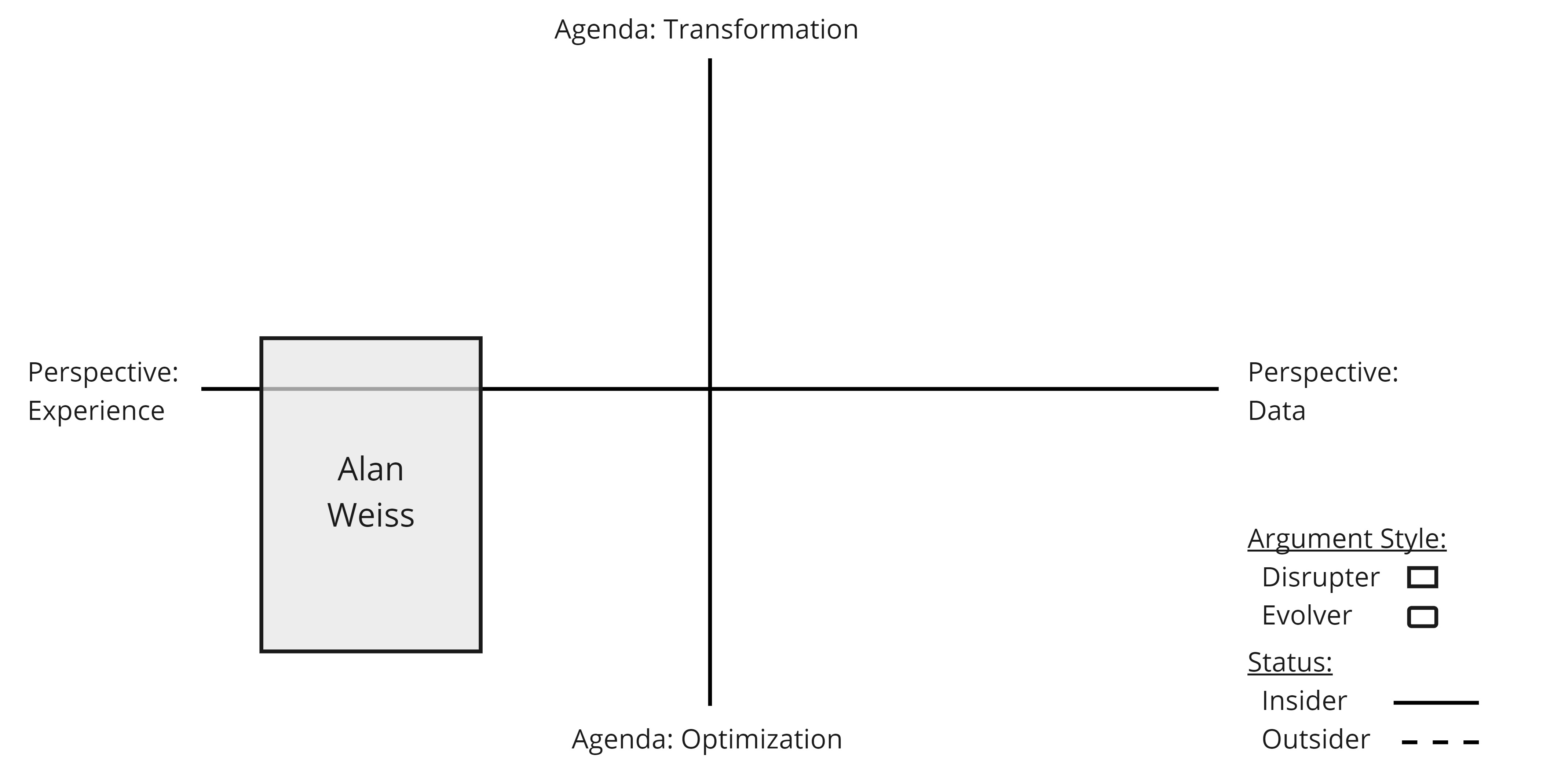
Alright, here are those blank POVSpace maps (and an electronic one: https://philipmorganconsulting.com/povspacemap). You can't do this mapping thing wrong, and the questions this activity surfaces for you will be productive ones even if you can't answer them immediately, so do give it a try!
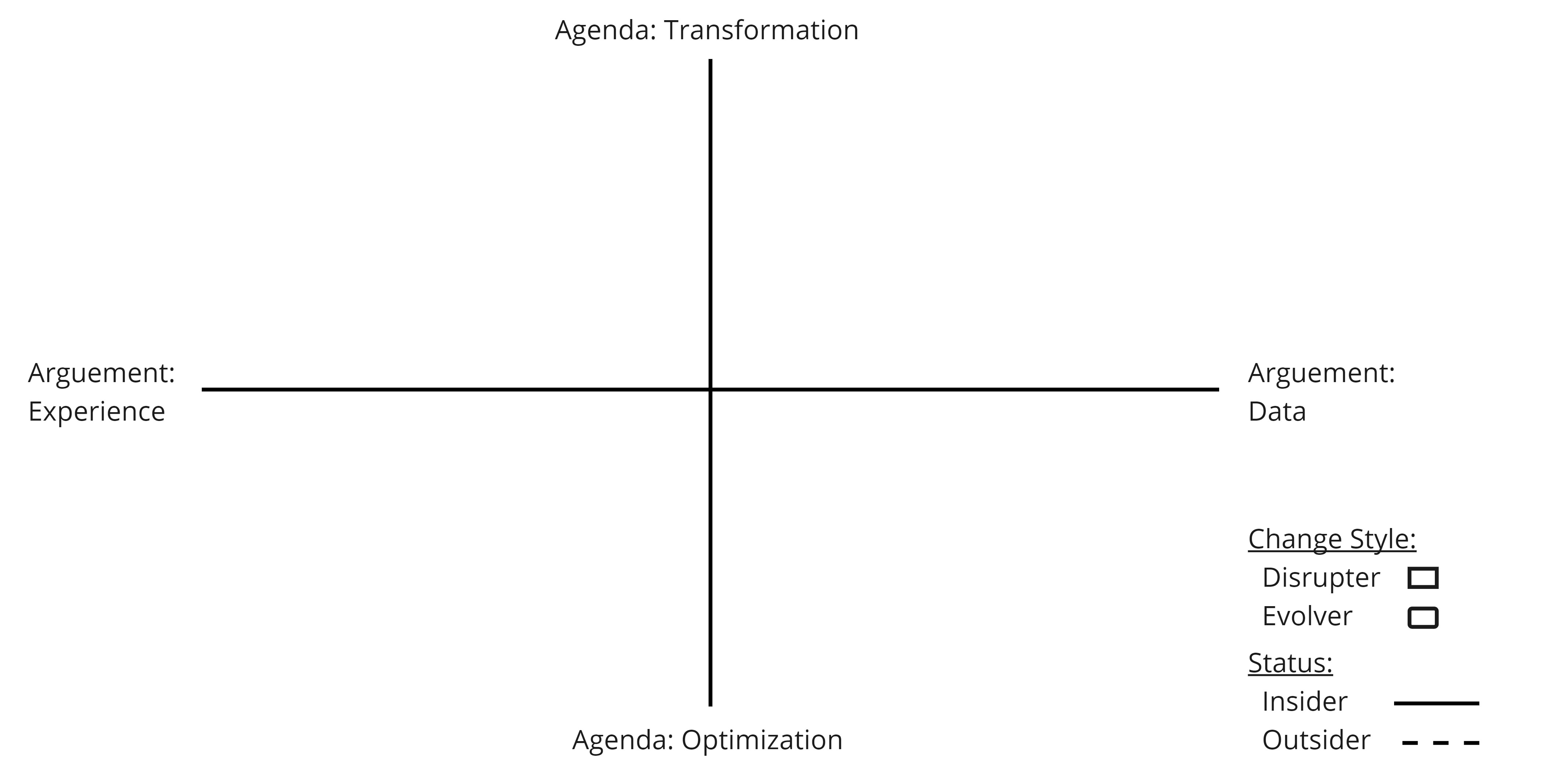
Surfacing POV Raw Material
If you have some level of clarity about where you are coming from in your POV, I can more efficiently guide you through the following questions that help you surface "raw material", which is ideas, opinions, and beliefs that might become an argument you want to put to your market. In other words, I hope you surface the somewhat rough, unpolished precursors to a more crisp, sharp POV.
I've grouped these questions based on where you might stand along the two primary axes of the POVSpace Map: Data vs. Experience and Transformation vs. Optimization. So someone whose perspective is more based in data and whose agenda is pushing or enabling an optimization for their market is called a Data-Based Optimizer and would focus on the questions in that section below. I hope the other groupings are named in a way that immediately makes sense to you. Of course you can look at all these questions, no matter which section they're grouped in. :) The questions are simple and open-ended in nature to provide you a jumping-off point for your own thinking and ideation.
Data-Based Optimizer
- What does your data tell you about the problem(s) your clients face? (Or others' data?)
- How might your data run counter to conventional wisdom?
- How might your data support conventional wisdom?
- Does your data suggest a specific sequence by which clients improve or make progress — a path that optimizes for lowest risk?
Data-Based Transformer
- What "icebergs" does your data tell you your clients are headed towards? (Imagine if The Titanic had radar or sonar and could have seen the iceberg it was headed towards.)
- Do you have data on radical/fundamental transformations out there in the business world that your clients would like to learn from? Can this data create a portrait or a story of these successes?
- Elite segments of military forces have entrance tests with objective criteria. Does your data suggest a similar sort of "go/no-go" criteria for potential transformation?
Experience-Based Optimizer
In the following questions, I'm going to refer to the traits or accomplishments that your audience admires as "ideals". For example, in the marketing vertical, commercially-successful creativity might be a very salient ideal, while in the finance vertical, it probably won't be.
- Your audience probably puts some people or companies on a pedestal because they admire those people or companies. Who does your audience put on a pedestal?
- Why does your audience admire these people/companies? What traits or accomplishments in particular does your audience admire?
- What ideals represent the "common sense" or obviously-desired states of being for your audience? (ex: Within team environments, diversity, alignment, and "great culture" are often considered self-evidently desirable states to work towards.)
- What behavioral ideals match the values or norms of your sector? (ex: Within academia and science, objectivity and elevating the pursuit of truth over personal gain are idealized.)
- What people or companies or institutions from outside your audience also match the ideals you've listed?
- What stories about challenge and change do you hear over and over again from within your audience? (ex: We are right to wonder if Apple could spin up an enviably profitable division that licenses all the stories about challenge and change that are associated with its brand. These are now almost more lore and legend than anything else.)
Experience-Based Transformer
- Who does your audience admire in a really emotionally-driven way, even if this person is far removed from your audience's day-to-day reality?
- What represents a "pure" or "Platonic" path of improvement for your audience?
- When your audience compares their sector to another, what are they comparing to and how?
- Are there specific versions of "The Hero's Journey" story that get repeated or have significant mindshare among your audience?
More General Question Prompts
The following may also be useful prompts. These aren’t specific to any particular perspective that you might be coming from.
Pattern Of Stupidity
You might notice a pattern of stupidity in your market or audience. Ultimately I’m going to ask you to run all your POV ideas through an “empathy filter”, but for now I’ll use blunt language like “stupid” to remind you that you’re not looking for subtle, little things; you’re looking for big, motivating issues to base your POV around.
- Are clients making objectively bad decisions?
- Where are clients not doing the hard work of being well-informed and thoughtful?
- Where are clients misunderstanding cause and effect?
- Where are clients following the herd rather than thinking for themselves?
Frustration Or Dissatisfaction
You might notice patterns of frustration in your market, or you may feel frustration on behalf of your market. These can be pointers towards a point of view.
- Where are clients being misled?
- Where are clients missing low-hanging fruit?
- What do your clients aspire to?
- Where do your clients face difficult external headwinds?
- What have your clients been putting up with or enduring?
Experience/Data
You may notice patterns in your own client-facing experience, or data that you have access to. These can be the precursors to good POV candidates.
- What patterns are quite clear to you?
- What previous client stories come up over and over again when speaking to prospects?
- If you had to give a conference talk based only on your client experience, what would the topic be?
- What "icebergs" does your data warn about?
The Empathy Filter
Every POV idea you come up with should be run through an “empathy filter”. When I talk about empathy, I’m not suggesting that you need to feel warm, tender, gushy feelings towards your market. Rather, I use the word empathy as a stand-in for the harder-to-summarize idea of being motivated by what would make things better for your market, being able to see things from their perspective, and trusting that acting directly in their best interest will also serve your best interest. Empathy in this book is more of a stewardship of your market’s best interest rather than a strongly felt emotion (though it can be the latter, too, and for some people it will be).
- Who benefits from buying into this POV?
- How difficult is it to implement this POV?
- What good reasons/counterarguments explain why this POV isn't already adopted?
- What good-faith misinterpretations of this POV exist?
Signals
The other elements of POVSpace — your status with your audience and your change style — are also important. They operate more in the world of "signals", which are more subtle things like how you phrase things, tone of voice, and so on.
Signaling Pedigree
The following might be ways you signal your pedigree, without clumsily saying, "You should listen to me because of my pedigree, bitches":
Name-Dropping I don't mean this in a negative sense here. What famous-to-your-audience people are you on a first name basis with? Who do you have access to? There are clumsy and artless ways to name-drop, but there are also artful ways to do this.
"When I was..." A prime example: "When I was at McKinsey, blah blah blah." This is the ole' authority-by-association move. As with every one of these pedigree-establishing "moves", overusage is going to get people's eyes rolling, but artful usage can accomplish what you want, which is a transfer of authority from the respected company, institution, or context to you.
"War Stories" Here you are presenting stories of success, case studies, and so forth that are interwoven with the source(s) of your pedigree. I think here of how Joanna Wiebe references writing a successful long-form sales page for Intuit. This is both referencing a household name and using a "war story" to argue for a specific POV (in this case, the claim that long-form sales letters are effective even in a modern SaaS context).
Style Of Dress can send signals about pedigree.
There are yet more subtle forms of signaling, too:
Diction Earlier in my career when I did tech writing work for an agency that did a lot of work for Microsoft, I noticed that every long-time Microsoft manager I interacted with speaks very quickly, under-enunciating syllables wherever possible and almost tripping over their own words. (If you listen to an interview with Ben Thompson, you'll hear a good example of this style of diction. The Conversations With Tyler interview is a good one to seek out.) I can't prove it, but I'm pretty sure that most of the 6 most recent US Presidents have made conscious choices to lean into styles of diction that signal a lack of pedigree to make them feel more relatable. Again, don't get in your head about this, but how could leaning into or away from your natural style of diction send the kind of signal you want?
Jargon And Phraseology You might use certain jargon or phraseology to signal your "insiderness" or "outsiderness". Even if this jargon is intentionally opaque to some, that may serve your pedigree-signaling purpose.
Signaling Experience
When you want to signal that you have valuable expertise, you can just present the expertise itself, but often you need to first earn enough attention to even have a chance to present your expertise or make a case based on that expertise. That's where you may need to signal that you have relevant, valuable expertise rather than just presenting the expertise itself.
The way this is done in books like Good To Great is to talk about impressively-large numbers; the number of file drawers filled by the book's source material, the number of hours spent collecting and analyzing it, and so on. Despite that particular book's fundamental methodological flaw, the basic authority-building approach of saying "I've looked at way more data than you have" is sound. Of course you wouldn’t say those exact words – that comes across as bluntly arrogant – but you can often earn a hearing for your POV with some variation of this opening gambit.
This gambit combines well with a "I'm not any smarter than you, but after looking at this much data, X is obvious, even to me" message, which artfully combines self-deprecating humility ("it's obvious even to an ordinary intellect like mine") with an appeal to authority ("I have more data than you, therefore I know more than you").
Another appealing framing takes the opposite approach. Rather than saying that your data or experience has a brute-force ability to prove your argument, you instead have noticed a pattern that few others have been careful or insightful enough to see. You've discovered a secret. Many will hold their skepticism in abeyance and their curiosity will give you an opening to support this heretofore-only-visible-to-you insight with your data, experience, or a combination of both.
Deep experience is the usual headwaters of expert confidence, and so confidence signals the upstream presence of deep experience. Many of us take someone's expert confidence as a proxy for the wisdom that comes from deep experience. This is a too-easily-hacked heuristic, thus the power of the confidence scheme. For us, we need to remember that deep expertise engenders both confidence and caution. If you want your POV to be impactful and your status is that of the expert outsider, lead with confidence and follow up with caution and caveats.
Signaling A Disrupter Change Style
The following will signal a disruptive change style:
- An urgent tone; an emphasis on need for dramatic change
- A command-and-control operating style (vs. consensus or coalition-building)
- Dismissing or downplaying objections to change (ex: "Just do it! It's not as hard as you think!")
- Using examples of disruption rather than evolution
Signaling An Evolver Change Style
The following will signal a more gentle, evolutionary change style:
- An emphasis on the importance of the resulting change (to keep folks motivated over the course of a potentially lengthy change)
- A consensus or coalition-building style
- Addressing and contextualizing objections to change or the actual risk of change
- Celebration of small victories
- Contextualizing the contribution of small actions to important/big outcomes
Ideation
In the workshop I've run on POV, I ask participants to make a personal copy of this Google Doc and freewrite their way through the set of questions that matches their POVSpace location: https://philipmorganconsulting.com/povquestions. I encourage you to do the same now.
At this point, these can be just opinions. They don't have to be finely refined POVs, and in fact going for that level of polish will dampen the effectiveness of the freewriting. The filtering and polishing comes later.
Immediately after doing this freewriting, list out every opinion you have that might be relevant to your current or future client work. You will structure these opinions into a POV "layer cake" format later, so if it's easier to just freewrite a list of all the relevant opinions, do that.
Again, the document where you can do this freewriting: https://philipmorganconsulting.com/povquestions.
Audience
I use the word audience to describe the group of people who will be exposed to your POV. This group might not be what you think of as an audience for your marketing. Instead, maybe they are the several dozen prospects you will speak to over the next year, not the thousands of people subscribed to an email list you don't actually have. Maybe they are the team of 25 employees who need alignment and leadership from you, not the 250 paid attendees at a conference keynote. You get the idea, right? Those who are exposed to your POV are your audience whether they are a small, ad-hoc group or a large intentionally-attracted group.
I'd like you to think about where your audience would lie on our POVSpace map. This will be a challenging and possibly frustrating exercise, but incredibly valuable no matter how confident you feel in your resulting map. It is challenging because your audience is never a monolith, no matter how intentional the invitation you extended to them. They are a group of people with differing backgrounds, purposes, and approaches to achieving those purposes. Nevertheless, try to map them (without covering the entire map from left to right and top to bottom with one big rectangle; that's a cop-out :)). Ask yourself: where is the center of gravity of their point of view? How do they see the world? What is their agenda for themselves? What is their change style? Even the best possible answer to these questions will be an approximation — a composite — but the increase in empathy and insight that comes out of this labor is well worth the cost.
Overlaps/Tensions
There will be some amount of overlap or difference between your location on the POVSpace map and your audience's location. This leads to an important question: how does this overlap or difference create leverage for you?
I wonder if you are imagining that any difference in your POV and your audience's POV is problematic. I don't think so. I think both overlaps and differences are sources of leverage; leverage that can be used to persuade, challenge, inspire, empathize, connect, or convince.
- Overlaps position you to reinforce or justify your audience's views to them. Their potential reaction: "I always felt this, but couldn't quite articulate/support it so clearly before."
- Differences position you to challenge or enrich their views with an outside perspective. The hoped-for reaction: "I've never seen things that way before..." or "wow, I'd like to achieve that!"
The work of getting really good at exploiting this leverage can be the work of an entire career. Or, it may come somewhat naturally and quickly to you. There definitely are points of view that aren't very relevant or important. But I'm convinced that every potential difference or overlap with your audience is a source of leverage you can use to make your POV more impactful.
Filtering Your Opinions For Good POV Material
The output of freewriting your way through those questions should be a bunch of opinions of varying quality. These are "POV candidates". If you try to avoid self-editing during the freewriting process, you increase the chances of discovering some good stuff that lies just outside the well-trod path of ideas you are normally focused on. Hopefully there is lots of good stuff in your list of ideas, but now is the time to ruthlessly filter that list in search of what might be impactful POV material.
Below are some qualities of a good POV. Some of these are qualities you should try to maximize, and some are qualities you aren't trying to maximize, but ones you should think more deeply about to understand how the POV in question fits (or doesn't!) with your larger agenda for your business.
Durability
Here are some questions that will help you evaluate the durability and potential longevity of a candidate POV:
- For how long is the candidate POV likely to be relevant?
- For how long will it be seen as a challenging perspective before it becomes mainstream or conventional wisdom (if ever)? What would have to change for it to become a mainstream POV?
- Consider how Dan Ariely's apparent use of faked research has cast a shadow over the entire field of behavioral economics. How exposed is the candidate POV to this kind of risk?
A POV doesn't have to be extremely durable to be worth investing in, but you do want to have a sense of a candidate POV's durability before you go all in on it.
Audience Benefit
Note
2: It probably is possible to re-frame a you-centered POV like this in terms of audience wellbeing/progress. Just because it starts out you-centered doesn’t mean it needs to remain stuck there.
To what extent is the candidate POV focused on audience benefit? If I did website work, it would be tempting to cook up a POV about how critical it is for clients to get their web developer the content they need in a timely fashion, but that would be a POV that quite transparently flows from frustration with project process, and doesn't place my audience's wellbeing and progress at the center of the POV. [2]
Saleability
Some people will agree with your POV, or even find it obvious because it so closely matches theirs. Others will need to buy into your POV. This kind of buy-in is a sometimes-costly but usually non-financial process that involves them coming to accept and agree with your POV. In essence, they adopt your POV and use it as part of how they see, interpret, and understand the world. They become intellectually and/or emotionally "bought in".
This is the right place for a reminder of this well-known quote from Upton Sinclair:
It is difficult to get a man to understand something when his salary depends upon his not understanding it.
For structural reasons, some people will never buy into your POV. Maybe their job or revenue model depends on never buying in. Perhaps they have no interest in updating their view of the world, or they have no incentive to endure the discomfort of even temporary cognitive dissonance. Some, however, do have that motivation or interest. For them, your candidate POV may present an intriguing or appealing possibility for growth and progress, but the buy-in process may be costly, requiring a lot of independent exploration or plain ole laborious thinking. How do you "sell" these folks on the candidate POV?
How much evidence do you have for the candidate POV? Evidence can be data, but it doesn't have to be. We humans also respond to stories about others' experiences (anecdata).
What are the implications of adopting your candidate POV? Does it merely provide a new/better way of understanding the world, or will it require further action, a shift in identity, or deeper forms of change in order to fully buy in?
Your candidate POV(s) may make a promise (to solve a problem or improve a status quo) to its audience. How attractive is this promise to your audience?
Note
3: You can benefit from the pursuit of something you do not ultimately achieve. I might benefit from running a marathon even if I come in last or can't complete the race; the training and effort and growth it creates has value independent of the outcome.
Ultimately, how pragmatic, achievable, or realistic is whatever you are explicitly or implicitly promising in the candidate POV? This doesn't mean you have to limit yourself to easily achievable promises, but it's worth reflecting on how many will ultimately realize and benefit from [3] the optimization or transformation you are advocating for.
Advisor/Implementer Positioning
The summer I worked as a waiter at The Olive Garden restaurant in Winston-Salem, NC, when I came home from work you could smell the musk of olives and Italian dressing from 6 feet away from me. In helping others refine their POV, I've seen some points of view that "smell" like implementation work, and others that "smell" like advisory work. This scent is usually not evident in the literal wording of the POV, but it's as easily perceived as the smell of olives and Italian dressing after my shift at the Olive Garden. So ask yourself: does each candidate POV on your list emit a "scent" of advisory or implementation work? If so, is this what you want to put out there into your audience and client base? If not, do you need to eliminate that candidate POV or merely re-frame it?
Conversational Potential
I've repeatedly emphasized that the core of your POV is an argument; a claim about what is true or how things should be done. Ideally, though, this is never a one-sided argument. Rather, it should be a jumping-off point for a variety of conversations. Conversations between you and a prospective client. You and an email list member. You and colleagues, etc.
I can't give any recipes or formulas to help, but I can urge you to consider the potential that your POV candidates do or don't have to spur conversations with your audience. Again, whether that audience is a single prospect in a sales conversation or a group of thousands, some of the best points of view are a starting point for some sort of conversation. This could be an inner mental conversation within an individual, between their priors and your POV's challenge to those priors. Or it could be an asynchronous conversation between a number of people carried out across books, articles, and social media. Or it could be a realtime conversation between people. In any event, a POV that leaves no room for conversation suffers reduced potential for impact. I won't offer any evidence to support this claim, instead I'll invite you to a mental conversation with yourself, or with me if the opportunity arises, to move you towards accepting or rejecting this idea.
Coherence
A good POV is coherent with your larger business agenda. This is both obvious and easily forgotten. It's probably obvious that if your business sells services that are optimizing in nature, you don't need to come out swinging with a bold transformational argument in your POV. And yet, the world as it is, and social media in particular, exerts a narcissizing influence on us. It's easy to forget that you don't have to have a strong, un-nuanced POV on every single issue of the moment, even if those issues are really important to your audience. Likewise, your points of view do not need to be driven by what authorities or famous personalities within your field are allocating their airtime to.
So it might be easy or sexy or popular to have a POV on X, but do you really care? (Also, a lot of these "of the moment" POVs are going to fail the durability test.) Do you want to do more client work around this POV's topic? If the POV is transformational, do you have the emotional budget to work at that transformation? Do you have the advisor/thought leader/consultant chops to enable that transformation within a possibly-hostile organizational context? So... is the POV coherent with your larger agenda, resources, timeline, "advocacy budget", etc?
In a way, coherence is the uber-quality, because it rolls up so many other of these qualities. This one asks: Is this POV the right instrument to support your larger business agenda?
• • •
I realize this part of the book might feel especially "mechanical" or "inorganic". This is the only way I know to reveal the kind of thinking I do when helping a client formulate their POV, but in reality that work is much more like a wide-ranging, messy conversation. A somewhat frustrating one, at times, to be sure, but usually an enjoyable mutual exploration. If you find this systematic approach laid out here to be somewhat cold or offputting, the best way to go about this for you would be to find a "thought partner", someone who can function simultaneously as champion, critic, and co-developer of your thinking, and talk through this stuff with them.
Info
- If you'd like to chat with this book as an OpenAI GPT: https://chat.openai.com/g/g-T7xWKogC6-the-point-of-view-gpt
- If you want to join my email list: https://opportunitylabs.beehiiv.com/